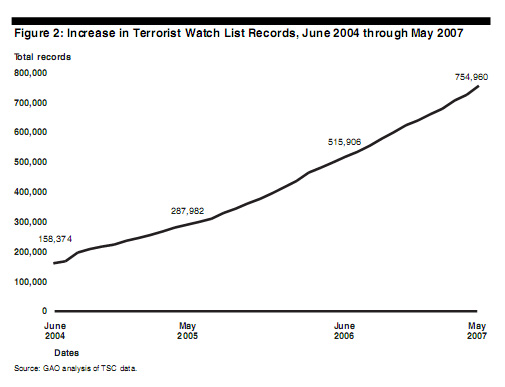860,000 Name Long Terror Watch List Scrutinizes Americans MostBy Ryan SingelWired Oct. 25, 2007 |
Popular 
Trump Confronts South African President on White Genocide

Israeli PM Netanyahu: Trump Told Me 'I Have Absolute Commitment to You'

Trump, After Rearming Israel, 'Frustrated' With Netanyahu for Expanding War

CNN: U.S. Officials Say Israel Preparing Possible Strike on Iran

ADL Responds to DC Shooting With Call to Deplatform Twitch Streamer Hasan Piker
  The nation's centralized watch list has grown to include 755,000 names suspected of having terrorist ties, resulting in nearly 20,000 positive matches of persons against the list in 2006, according to a new report from Congress's investigative reporting arm. Since the list is now used in nearly all routine police stops and for domestic airline travel, Americans made up the bulk of those matches. The nation's centralized watch list has grown to include 755,000 names suspected of having terrorist ties, resulting in nearly 20,000 positive matches of persons against the list in 2006, according to a new report from Congress's investigative reporting arm. Since the list is now used in nearly all routine police stops and for domestic airline travel, Americans made up the bulk of those matches.The Government Accountablity Office's report was presented in a hearing to the Senate's Homeland Security Committee Wednesday, causing senators to express concern about the size and effectiveness of the list. The GAO report (full pdf, html summary) included a few new details about the list's size and operation but much of this was reported by Wired months ago. The Terrorist Screening Center runs the list, which is created from nominations from a wide array of government agencies via the National Counter Terrorism Center. The watch list entries are used to check persons seeking visas, travellers entering or leaving the country, domestic airline passengers and persons stopped by state, local or federal law enforcement. Most of the positive matches on the list came from police routinely checking persons, such as speeding motorists, against the list, according to the Government Accountablity Office's report (.pdf). The TSA is responsible for resolving mismatches, which can happen when an innocent person's name is similar or the same as different, watch listed person. The number of individuals on the list may be significantly less than three quarters of a million, since the name count include aliases. Since list entries are coded with varying suspected threat levels, simply being on the watch list doesn't mean one will be arrested. In fact, being on the watchlist isn't even enough to ensure that a person is denied a visa or entry into the country, according to the report. The GAO, at the request of the feds, removed information about how often the list has been used to arrest suspected terrorists or keep them out of the county. It also doesn't report the number of times people were falsely matched to the list. But the report says the feds say it is effective. Our analysis of data on the outcomes of encounters revealed that agencies took a range of actions, such as arresting individuals, denying others entry into the United States, and most commonly, releasing the individuals following questioning and information gathering.Individuals who believe they are on the list erroneously or because of a confusion over their name can apply for help through the DHS Advise system, but it is not set up to allow people to contest the information that got them on the list. Homeland Security officials defended the list's size and said they were working to make sure that watch listed individuals did not get past airline checks, according to the Voice of America. Homeland Security Assistant Secretary of Policy, Paul Rosenzweig: "We have made great strides," he said. "More work needs to be done, but the improvement is quite noticeable."Other adjectives that apply to the DHS review process include one-sided, secretive, administrative, and non-reviewable. |



